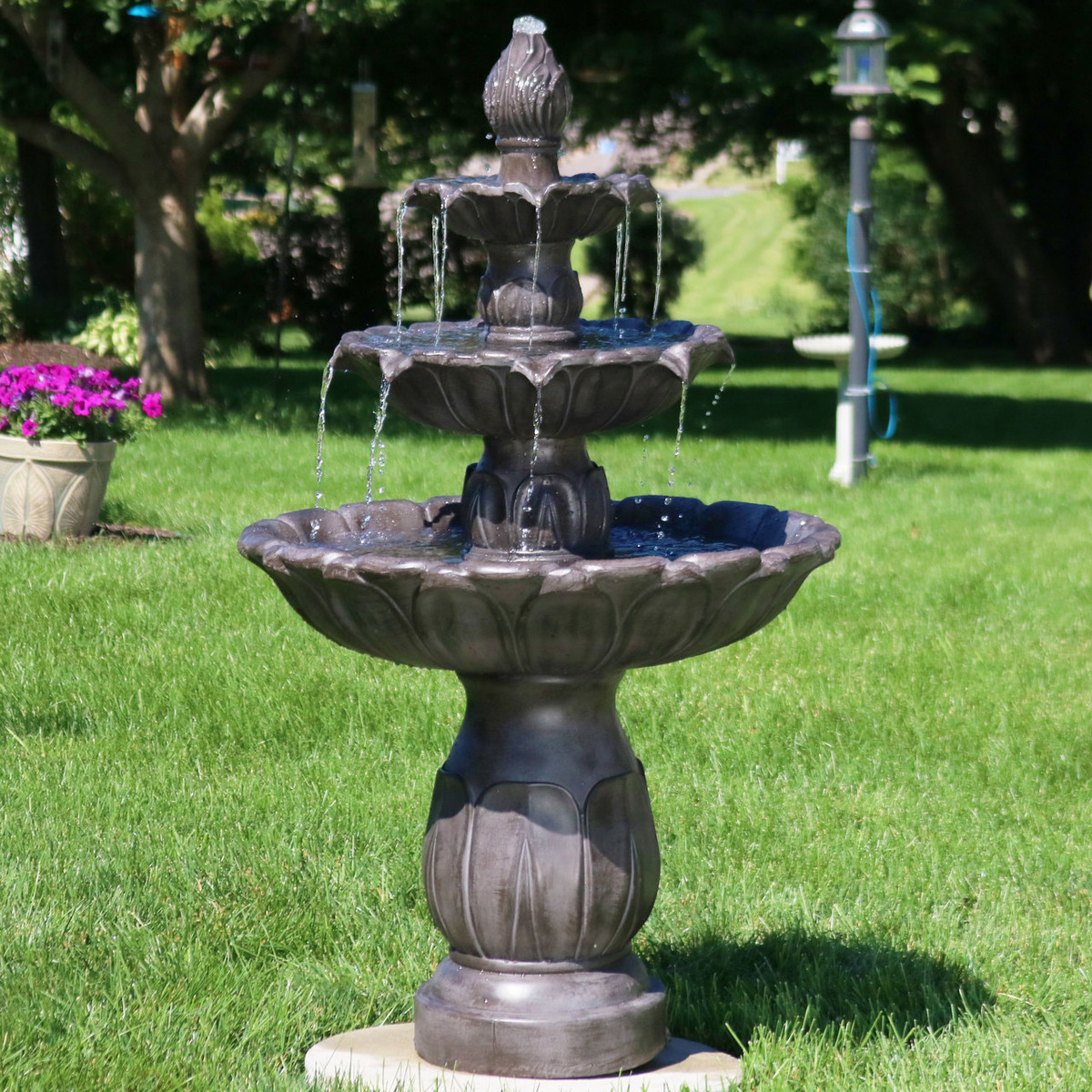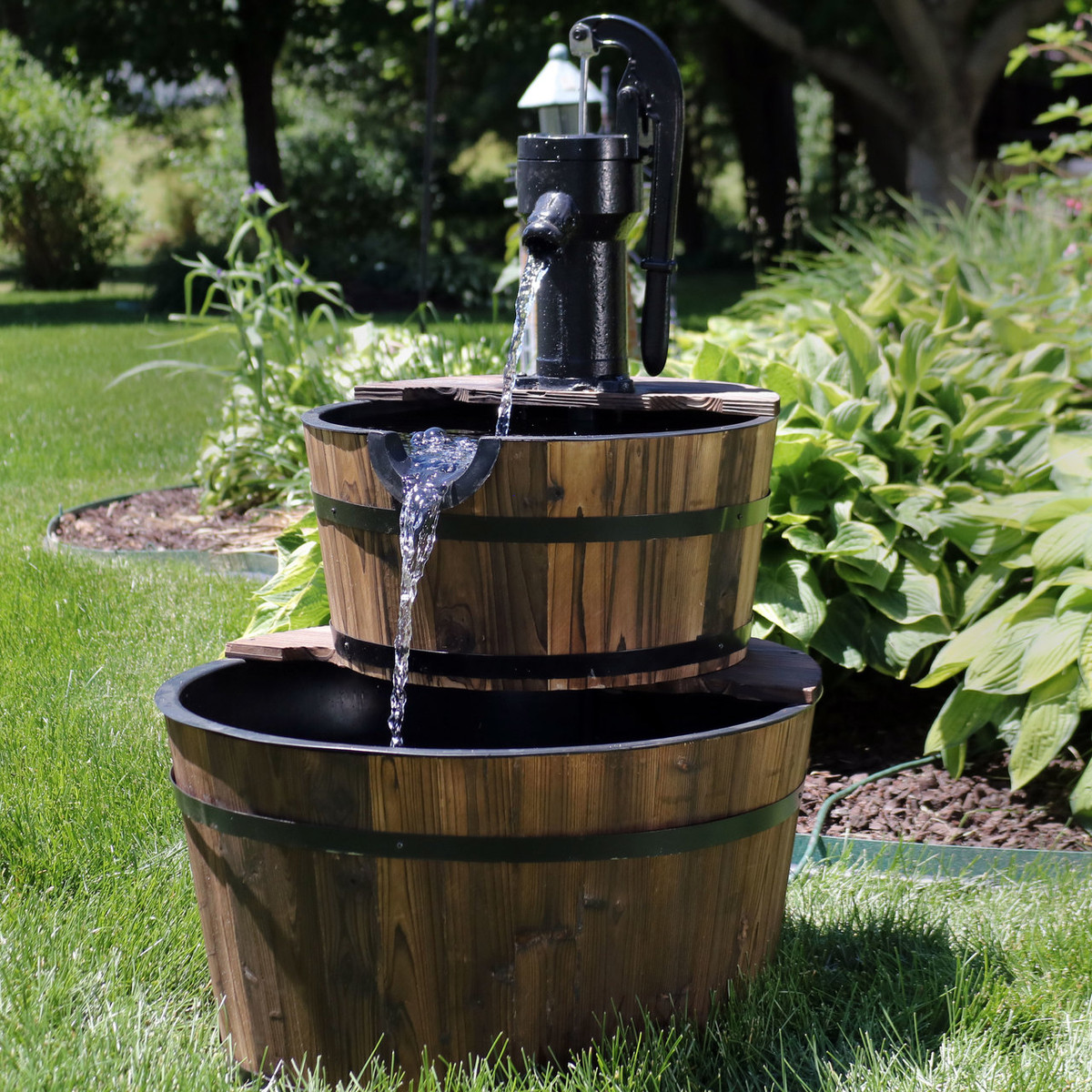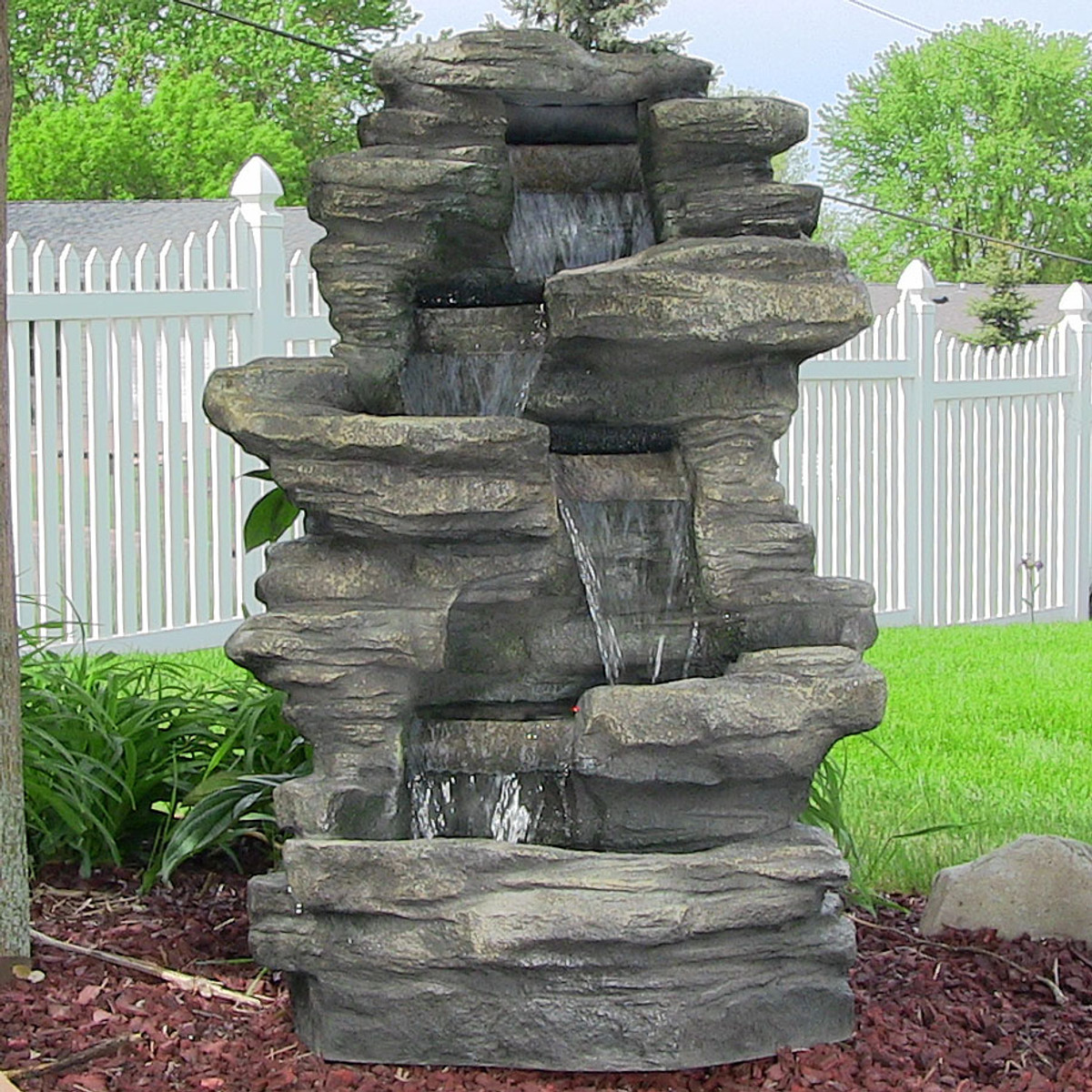A Guide to Outdoor Water Fountains: What’s Right for You?

For those that are always looking to add beauty to their backyard garden, adding a water feature is something that should be considered. There isn’t much that creates a more Zen-like experience than the calming sounds of trickling water or just being around water.
How do Garden Fountains Work?

A garden fountain isn’t a complex mechanism but smoothly operates through a simple recirculation process. There are really only a few components to a water fountain listed here:
- Water Pump– The device that controls the circulation of the water through the fountain
- Basin or Reservoir– This is the main container that holds the fountain water and where the pump remains located.
- Power Cord or Solar Panel– Connects to the water pump to provide the energy source for operating the pump.
- Water Tubing– Vinyl tubing that brings the water back to the pump from various tiers.
- Tiers– Different levels or platforms of the fountain.
The water pump is the heart of the fountain. Water is sucked in through the pump housing and pumped out by a motorized propeller. This pushing the water out gives it the volcanic-like appearance. The water comes back to the pump through the water tubing and continues the recirculation process.
What are Fountains made of?

There are several types of material used for outdoor fountains. Each type of material offers variations that add value. When choosing a fountain it’s going to be important to think about things like weight, durability, and appearance.
For example, if you live in a climate that has harsh winters, you may want to store your fountain indoors, so having something that is lighter weight will be easier to maneuver.
Cast Stone
This has been used in architecture for hundreds of years by mimicking natural cut stone. It’s created through a cement mixture process and various pigmented color can be added. This is a very durable product.
Fiberglass
A lighter material that makes it easier for those that need to move their fountains around. One of the easiest to assemble. It’s not the most long-lasting product. It’s easier to work into different forms or shapes.
Copper
One of the most expensive options that provides a unique look.

Ceramic
This option usually takes on the appearance of traditional pottery. These fountains tend to be smaller in size making them optimal in tight spaces. Many different color schemes.
Brass
This isn’t a material that you’re going to want to move around at all. It’s often found in fountains that have more of a sculptured look.
Stainless Steel
A clean modern look that never rusts or wears. It’s built to last a long time.
Stone
One of the more natural looking options. Stone can be carved to take on many different appearances. Utilizing different types of stone like granite and marble add to the look.
Polystone
Another option for a lighter material. Polystone can take on many different appearances like wood, stone, or metal. It’s a good cost-effective option.
Glass Fiber Reinforced Concrete
Glass fiber that is mixed in cement to keep that glossy look. This material binds to become very strong.
Types of Water Fountains
There are many different variations of outdoor fountains, but here are a few of the more popular variations.
Tier
A tier fountain is from a traditional Spanish style with a large basin at the bottom and then two or three additional smaller size basins(tiers) stacked above each other. The water flows from the smallest top tier down to each larger tier making its way down to the largest bottom basin.
Waterfall
A waterfall fountain is when the water runs off the top of an object down into a basin below. It’s typically a rock structure that the water flows down, but can be other objects.
Birdbath
The birdbath fountain accentuates a single large basin. Birds tend to sit on the edge and drink the water within the basin. It’s a great feature for those that enjoy observing various birds in their garden.
Wall
These fountains run parallel to a wall like up against the side of your house. These can also be utilized indoors.
Column
A column fountain has one main large post that the water bubbles up from the top of the post and runs evenly down all sides of the column or post.
RELATED POST: Why You Need an Entrance Arbor for Your Garden Today
Should I Leave my Outdoor Fountain on?
Yes, It’s important to leave your outdoor fountain running for a couple of reasons. The first is that the water pump is made to be continuously running. It can cause more strain on the pump when it frequently has to start and stop.
Secondly, standing water is never a good thing. It attracts mosquito populations and also can become a host to bacteria or parasites. Keep the water circulating. Check your water levels from time to time to ensure that it remains high.
How Do You Clean Outdoor Fountains?
Periodically check the fountain for any visible debris that may have dropped in. Wind or other weather conditions can cause leaves, limbs, or stones to go into the fountain.
It’s a good idea to do a full cleaning once per month. This is a fairly simple process by first unplugging the pump and draining the fountain. Loosen and remove the pump to clean separately.
Using a mixture of 50-50 vinegar to water can be used to soak the pump. The vinegar will help remove any mineral build up on the pump. After soaking the pump in the vinegar solution, dry it off, and remove any debris that may be inside under the cover.
Use a stiff-bristled scrub brush to clean the fountain by using the remaining vinegar solution and add baking soda as needed to remove difficult stains. Rinse the fountain down and dry. After cleaning, piece everything back together and refill with clean water.
Do Water Fountains use a lot of Electricity?

A lot depends on the size of the pump. A good average for a standard size backyard fountain ranges from 30-60kw per month. If you’re worried about the cost of running your fountain 24 hours a day, you’ll be relieved that it’s really not as expensive as you may think.
Here is a formula for calculating the overall cost to run your fountain per month:
# of Watts x 720 (Hours in a month) / 1000 = kW of consumption per month kW consumption per month x $ per kW hour = monthly cost
For example a 60 watt pump that pushes 930 gallons per hour at .067 kW per hour would cost:
60 x 720/100= 43.2 kw per month, 43.2 x .067 = $2.89 per month
Do Solar Fountains really work?
Solar fountains definitely work and can be an amazing option. For those of us living in sunny areas, like the Arizona desert where I reside, solar fountains are the way to go.
You may pay a little bit more up front, but then never have to worry about power cords or added costs to the electric bill. If you’re in a location that is frequently overcast or you don’t see the sun as much, it’s best to stick with an electric fountain.
A true solar fountain doesn’t store any energy so will only operate when receiving direct sunlight. Solar on demand options are the better way to go.
These solar fountains also contain a rechargeable battery, so the battery charges with direct sunlight and will keep the fountain functional when the sun is gone.
Water Evaporation
Getting a larger fountain can help slow the evaporation process. If you’re running a fountain in a hot climate or just enduring a typical hot summer, then it’s inevitable that you’re going to get some evaporation.
Make sure that you’re topping it off periodically so the water level doesn’t drop below the pump’s intake tube. If the water level seems to be dropping frequently, check for any potential leaks, and repair as needed.
Best Water Fountains for Your Garden
After searching for many different varieties and variations of water fountains. I’ve come up with a list of the best available options for your consideration. My criteria were based on appearance, cost, quality, and customer satisfaction. Here is my selection of the best water fountains for your outdoor garden space.
Concrete Bayborough Fountain – Click Here for Pricing

- Glass Fiber Reinforced Concrete
- 20″W x 20″L x 21″H
- 138 lbs
Sunnydaze Classic Tulip Three-Tier– Click Here for Pricing

- Dimensions: 25″ diameter x 46″ H; weighs 52 lbs; Recommended water capacity of 4 gallons
- Durable Polystone Construction
- Includes electrical 140 GPH pump with 1/2″ diameter hose and 16′ cord
Country Gardens Two-Tier Solar On-Demand– Click Here for Pricing

- Country Gardens Fountain Size: 21″ diameter x 32″ high — Weight: 38lbs.
- Solar Pump included
- Lightweight Resin Material
Sunnydaze French Lily Wall Fountain -Click Here for Pricing

- Dimensions: 20″ Wide x 9″ Deep x 33″ High, 18.4 lbs; Recommended water capacity of 3 gallons
- Mounts against any surface using a sturdy hook, screw, or nail
- Material: durable polystone
Sunnydaze Rustic 2-Tier Wood Barrel– Click Here for Pricing

- Dimensions: 23.5″ diameter x 37.5″ H; 30.8 lbs
- Material: Fir, metal, and plastic
- Features decorative iron hand pump with plastic coating
Stacked Shale Electric Outdoor Waterfall– Click Here for Pricing

- Dimensions: 27″ W x 23″ D x 38″ H; 35 lbs; Water capacity of 7 gallons
- Material: durable polyresin and fiberglass
- Includes: 1 fountain, 1 electric submersible pump, 2 plugins, and 4 LED lights
Pallisades Fountain by Campania International– Click Here for Pricing

- Proudly designed and manufactured in the United States from premium cast stone concrete.
- Dimensions: 37″W x 36″H, 625 lbs
- Includes a whisper-quiet electric, UL-listed pump. No plumbing is needed. Water recirculates within the fountain.
DIY Water Fountains

If you’re the do it your self type, I didn’t forget about you. These options will give you some guidelines or just get the creative juices flowing to help you design your own fountain. Try these 22 DIY Water Fountain Ideas here at Country Living or check out the below video for some creative ideas.
